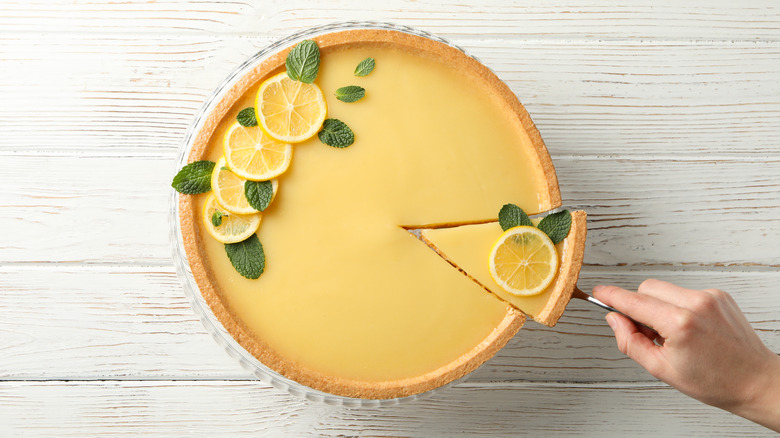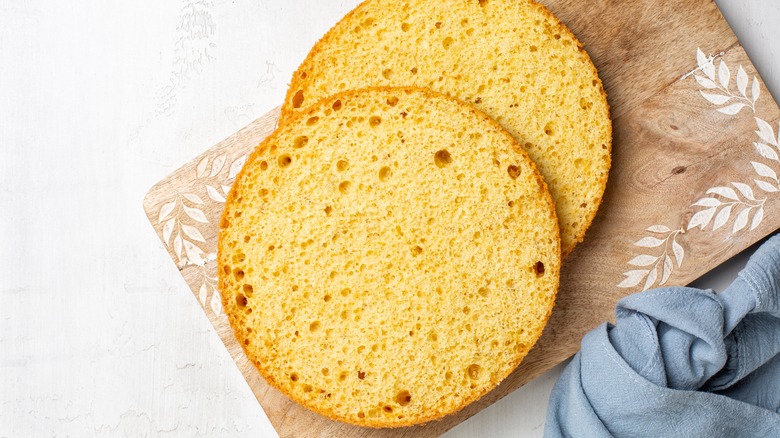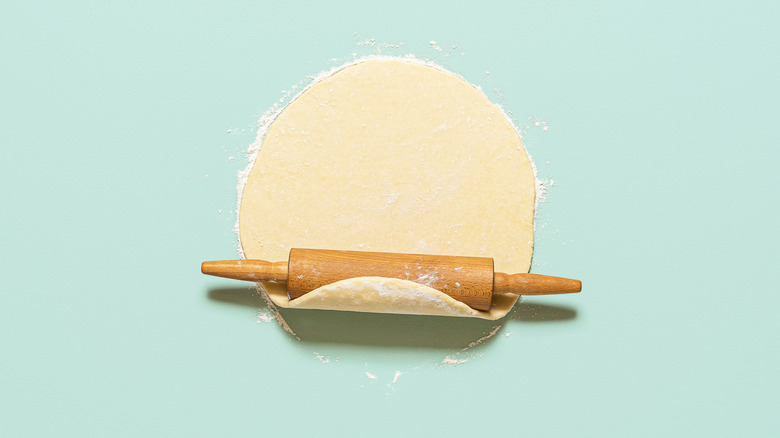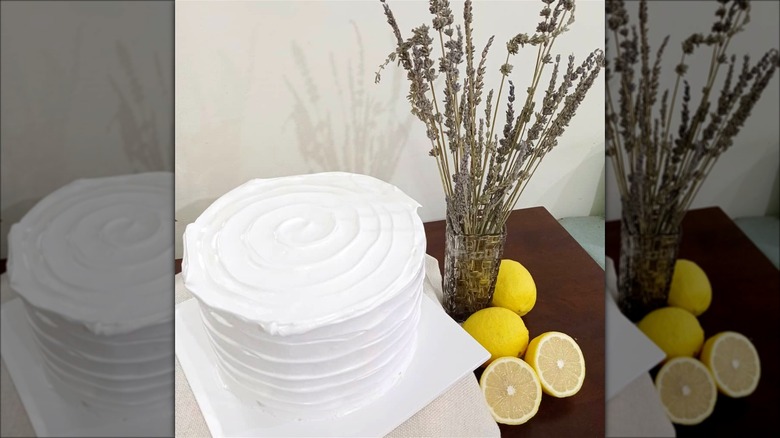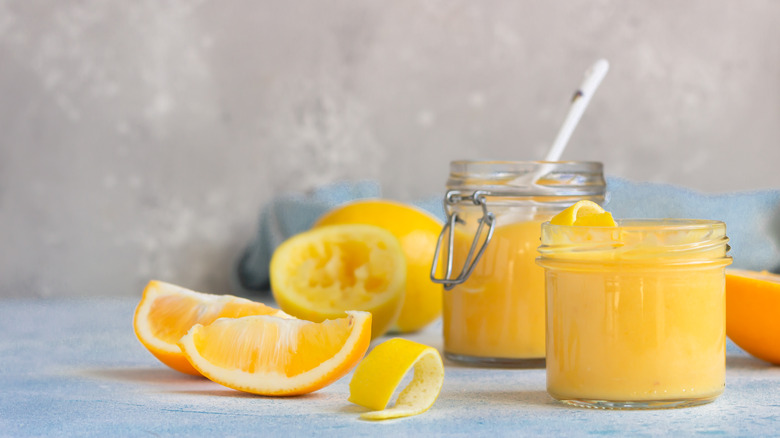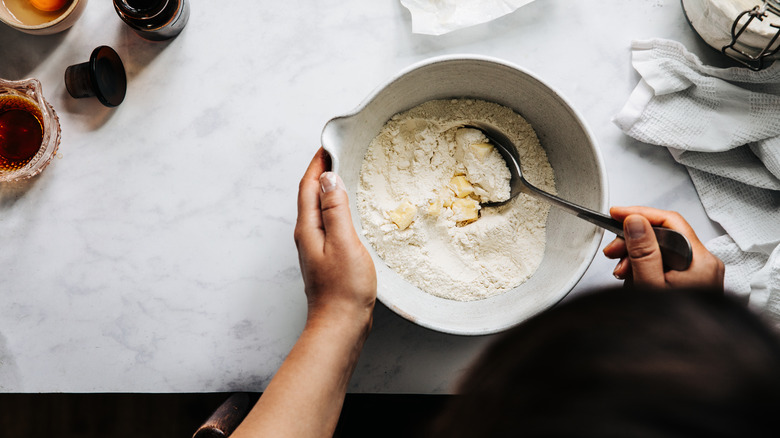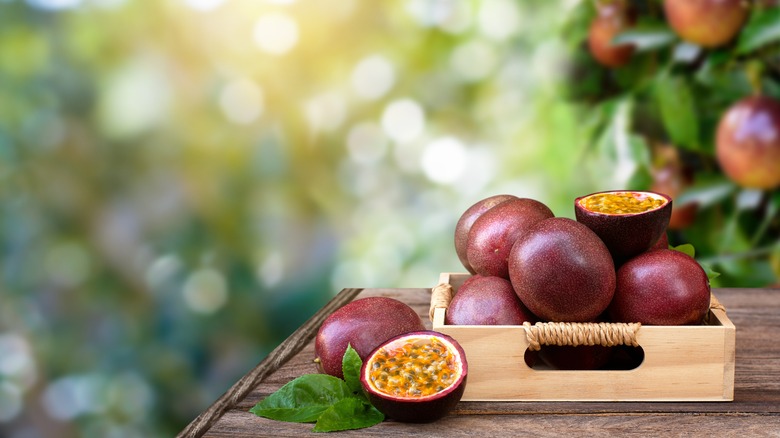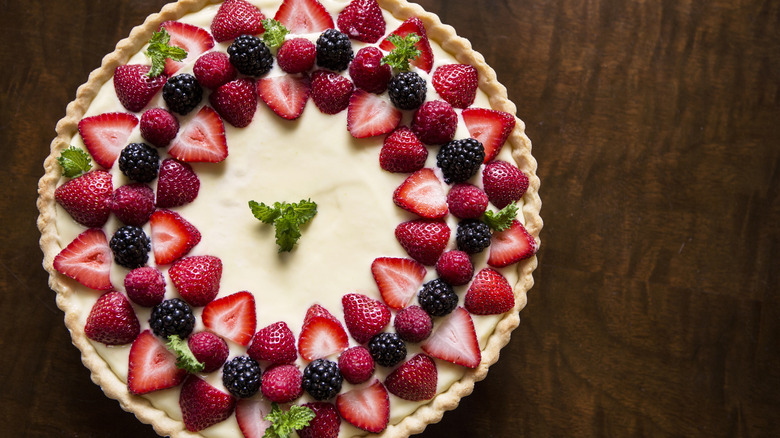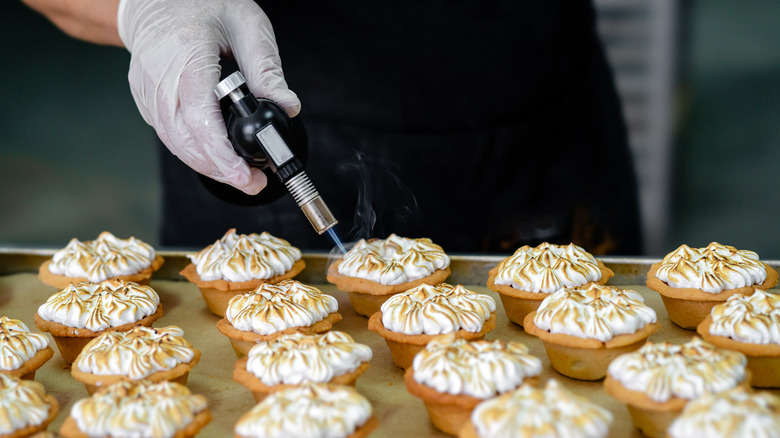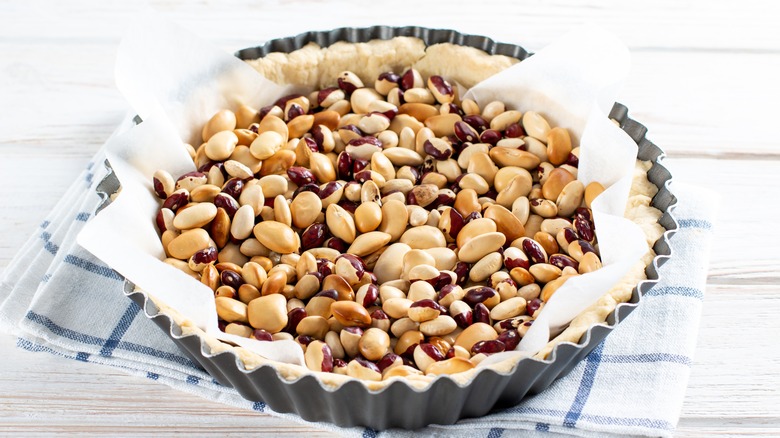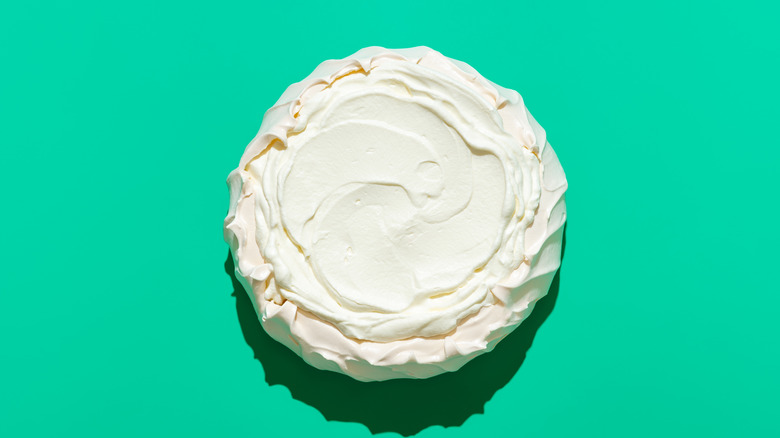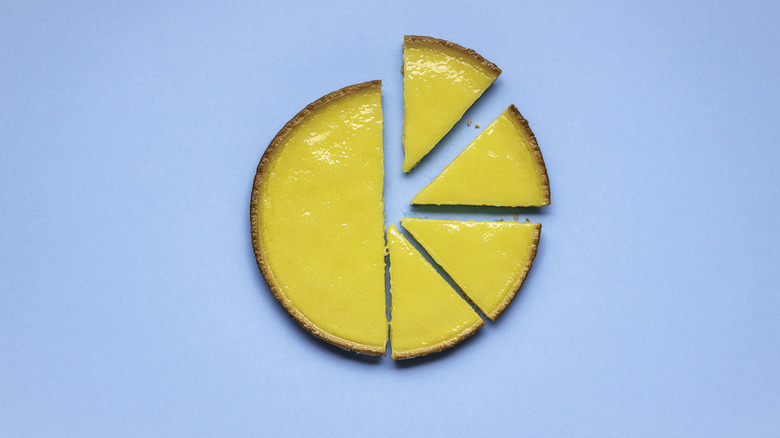Lemon Meringue Cake Vs Lemon Tart: Everything You Need To Know
Lemon tastes delicious in almost anything. Whether you're making a cake, a cup of tea, a salad, or a roast chicken, a squeeze of lemon and a sprinkling of its zest can easily brighten the flavor of the other ingredients and bring them together in perfect harmony. In addition to using this multi-purpose citrus fruit as an accent for other flavors, you can turn it into a mouthwatering main player, giving it room to shine and using all the supporting ingredients to show it off in its best light. Lemon bars, lemon mousse, and lemon bundt cake are all recipes we're partial to, but there are two lemon-based desserts that every pastry chef, whether they're an amateur, professional, or somewhere in between, should try at least once to discover all of the potential that lemons have to offer.
Lemon meringue cake and lemon tarts are the two desserts that will thrive at any dinner party. They are as delicious as they are visually appealing, with balanced textures, a pop of flavor, and just the right amount of sugar to please just about anyone. Between these two desserts, however, there are many differences that will determine which is the best option for you depending on the occasion.
There are quite a few matters of texture, technique, presentation, and adaptability to consider, so we've spoken with three experts to bring you all the information you need. This will help you decide which one of these delicious, lemony desserts is right for you.
Lemon meringue cake features a sponge base
The primary difference between lemon meringue cake and lemon tarts is that the former is, as its name suggests, cake. Instead of a buttery crust base, it's composed of fluffy layers of sponge held together by layers of lemon curd and encased in a thick layer of meringue. The cakes typically include a subtle hint of lemon to complement the curd, though you can always adjust the amounts of lemon zest and juice depending on your preference.
One of the difficulties of lemon meringue cake is that all those layers are challenging to get right. Erin Clarke, best-selling cookbook author and the recipe developer behind Well Plated by Erin, suggests that when it comes to the sponge, we should all "embrace them as the delicious, character-building project they are and [not] shortcut steps that are critical to starting you off with tender, fluffy cake layers."
These steps include using cake flour, sifting the dry ingredients, and incorporating the eggs into the batter one at a time. When it comes to lemon meringue cake specifically, Clarke recommends that you allow your cake layers cool completely before assembling them to avoid melting curd. "To help your assembly go as smoothly as possible," she continued, "trim the layers so they stack evenly, and for goodness sakes, be sure to butter and flour your cake pans well to begin with, so that you don't lose all of that effort to a stuck-on cake."
Lemon tarts feature a pastry crust
Though they do not pose the same multi-layer challenges of a lemon meringue cake, lemon tarts have their fair share of pitfalls, too. The first issue the crust that forms the tart's distinctive, buttery base. Luckily, Laura Kasavan, the food photographer and recipe developer behind the blog Tutti Dolci, has several tips and tricks up her sleeve to get you started. "To make a crisp and tender homemade tart crust, I recommend a classic sweet tart dough," she tells Mashed. "Also known as pâte sucrée, tart dough differs from pie dough in that it's enriched with an egg or egg yolk. Some recipes also include a little heavy cream to add moisture."
While you might assume that butter is responsible for the melt-in-your-mouth texture of tart crust, Kasavan reveals that powdered sugar is largely responsible. If your recipe calls for granulated sugar, consider swapping it with the powdered variety to improve the final product.
Even with detailed instructions, making tart crust can be so daunting that people avoid the entire recipe. Kasavan has a solution. Instead of making the dough from scratch or purchasing a pre-made crust from the store, use shortbread. "You can make your own shortbread from scratch with all-purpose flour, butter, sugar, and salt," she explains, "or you can combine shortbread cookie crumbs with melted butter and mix until the mixture forms large crumbs. Press the crust into the tart pan, and you're ready to bake, no rolling required!"
Lemon meringue cake is covered in meringue
Perhaps the most intimidating part of a lemon meringue cake recipe is crafting the meringue coating. Snow white and light as air, it looks like a feat of witchcraft rather than cooking. The beauty of meringue in this recipe, aside from its airy texture and glossy sheen, is that it prevents food waste. The lemon curd sandwiched between cake layers is made from egg yolks and without meringue, the leftover whites could be discarded or left to languish in the fridge.
There are several keys to achieving a lofty, glossy meringue. The first is a clean, dry bowl. Any traces of oil or water will hinder the process, leaving you with limp and soggy rather than stiff and glossy meringue. Clarke points out that oil can sneak into the mixture from specks of egg yolk and suggested taking extra care when separating the eggs. She also discourages the use of store-bought egg whites, explaining that, "while tempting for their convenience, egg whites in the carton won't whip."
Another issue that can arise is "weeping," where the meringue is solid but dotted with water droplets. To avoid this precursor to sogginess, Marie Roffey of food blog Sugar Salt Magic, says that you must dissolve the sugar before you add it to the egg whites. "Sugar crystals attract water molecules from the air," she explains, "and this is one of the most common causes of a weeping meringue."
Lemon tarts are filled with lemon curd
Both lemon meringue cakes and lemon tarts contain curd, but while the former involves only thin layers of curd, the latter is comprised mainly of the tangy, custard-like substance. Lemon curd gives the word "tart" a double meaning, lending a punch of flavor that will set your tastebuds alight in the best way. Creamy and smooth, it is also texturally decadent and complements the buttery crust.
It can be just as tricky to make as meringue, however, namely because it involves cooking eggs without scrambling them. As Kasavan explains, "overcooking lemon curd can cause the texture to go from silky smooth to lumpy." To avoid this, she recommends cooking the curd over moderately low heat while whisking constantly. "Cook until the curd is smooth and thickened and coats the back of a spoon," she continues, adding that you should be able to trace a line through the curd with your fingertip.
She also suggests cooking it over a double boiler instead of direct heat to avoid solidifying the yolks. Once it's cooked, Kasavan recommends straining the curd through a mesh sieve to remove any lingering lumps or lemon zest. Another pro tip? "If you're making the curd ahead of time, press a piece of plastic wrap directly against the surface of the curd to prevent a skin from forming as [it] cools."
Lemon meringue cake is typically full of gluten
With its layers of airy sponge, lemon meringue cakes are difficult to alter for those who do not or cannot eat gluten. The major challenge in making a gluten-free version of the cake is replicating the structure and especially the fluffiness of a gluten-based sponge. Gluten gives cakes elasticity and rise, which is particularly important for lemon meringue cakes given that the weight of the curd and the thick meringue coating works too compress the sponge layers. Gluten-free flours often lack the binding properties of gluten, leading to a crumbly texture or, worse, a dense one.
That doesn't mean a gluten-free meringue cake is impossible, however. If you decide to make the recipe with gluten-free flour, keep in mind that different types of flour provide different results. For example, almond flour is an excellent option for rich, moist cakes, but it does not provide a solid structure for layer cakes and tends to be both crumbly and dense.
Remember also that lemon curd provides plenty of moisture, so you likely will not need to worry much about using a flour that produces a dry texture. Look for products that are advertised as cake flour or all-purpose flour. There is no single ingredient that can perfectly replace gluten-based flour, so products that are labeled as gluten-free cake flour or all-purpose flour will usually be a mixture of ingredients that is calculated to provide a combination of airiness and springy texture.
There's an easy trick to make gluten-free tart crust
Making pastry can bring even the most experienced chefs to tears. If you roll the dough too thick, it could be dense and underbaked. If it's too thin, it can tear easily. If it's too warm, it will fall apart when you try to move it and may also have a rubbery texture when baked. If it's too cold, it may be too hard and you won't be able to even begin rolling it.
Finding the right balance takes practice and a good recipe, even when you're using gluten-based flour. Gluten-free flour poses even more issues. Gluten is a protein that binds ingredients when mixed with liquid. Without it, your dough may not hold its structure and will be inclined to crumble. You can add xanthan gum to your gluten-free flour, a binding agent that is frequently found in gluten-free recipes, but there is an even simpler and more effective solution.
As Kasavan suggests, you can swap the pastry for a mixture of store-bought, gluten-free shortbread and butter. Blend them into a smooth dough, place it into a tart tin, and press it in with your hands. This skips the step of rolling the dough out and transferring it to the tin, which may prove next to impossible with gluten-free dough. If you can't find gluten-free shortbread at your supermarket, you can always make your own. Shortbread is meant to be crumbly anyway, so it's perfectly suited to gluten-free flour.
Lemon meringue cake is surprisingly versatile
Despite its distinctive appearance and potentially complicated process, lemon meringue cake is surprisingly adaptable. For one thing, it can be simplified fairly easily, which is a boon for anyone who finds all those steps a bit daunting. Clarke suggests making a simple lemon loaf cake, frosting it with meringue, and then spreading each slice with lemon curd before serving them. You could even use store-bought curd in a pinch.
As for flavor alterations, Roffey has tried several with delicious results. "This is actually quite a versatile recipe," she says. You can swap out the lemon curd for practically any other type of curd, including passionfruit, orange, lime, and blackberry. The benefit with these subscriptions, as Roffey explains, is that you don't have to change anything about the rest of the recipe, since they all work well with the lemon cake batter.
For a more adventurous spin on the recipe, Roffey recommends using chocolate, though you'll want to replace the lemon juice with water and a teaspoon of vinegar while omitting the lemon zest. A chocolate crème patissiere can stand in for the lemon curd and the meringue can stay as-is.
Lemon tarts can be dressed up with other ingredients
When you make a lemon tart, you're creating a pastry that, for many, is the definition of culinary elegance. Its power lies in its simplicity. With only lemon curd and a pastry crust in the most basic recipe, there is no icing or fancy fillings to distract from the quality of the key components. Each element must be executed with precision for the final product to shine. However, there are ways to decorate a lemon tart without compromising its trademark elegance or detracting from its powerfully tangy flavor.
"Swiss meringue or lightly sweetened whipped cream both add a lovely creaminess that complements the bright lemon filling," Kasavan says. The first option is an excellent way to use up those leftover egg whites from the lemon curd-making process, while the second allows rich dairy to complement the acidity of the filling. If you want a more colorful design, Kasavan recommends using fresh berries, edible flowers, or a garnish of lemon slices with a dusting of powdered sugar.
Lemon meringue cake typically requires a blowtorch
Blowtorching your food is one of those gourmet cooking techniques that will seriously show off your culinary skills. However, it also carries a serious intimidation factor. For many home cooks, open flames and kitchens are two things that normally do not go well together, and breaking that instinct should not be taken lightly. With these facts in mind, however, it is also true that a lightly caramelized meringue is a thing of beauty. At the right time, whipping out a blowtorch (with the proper precautions, of course) is ridiculously fun.
Clarke shares key advice for first-time kitchen torchers, pointing out that, while the flame is pretty small, you should make sure you have a fire extinguisher on hand just in case. Position the cake on a surface that is clear of clutter to avoid accidentally caramelizing your fruit bowl or incinerating a too-close cereal box. As for technique, Clarke says to "hold the flame about [one and a half to three] inches away from the food. Use a sweeping motion and keep the flame moving — if you stay in one spot too long, you risk burning the food."
Lemon tarts require blind baking
You won't gain much by blowtorching a lemon tart, but blind baking is the deciding factor in whether your tart's crust is crispy and tender or soggy and rubbery. Most recipes do not ask for you to bake the filled tart, so your crust will be completely raw if you don't put it in the oven before adding the curd.
Once the crust has been rolled out and transferred to the tin, next chill it in the refrigerator to ensure that it will hold its shape. Then, to blind bake it, Kasavan advises that you line the shell with parchment paper. Next, fill it with pie weights (dry beans or chickpeas work just as well if you don't have any) and bake it at 350 degrees Fahrenheit until it is fully set and golden brown around the edges. When you take it out of the oven, Kasavan says that you should "carefully remove the parchment paper and weights, and return the pan to the oven for a few more minutes until the bottom is also golden brown."
The most important part of blind baking is to let the crust cool completely before you add the filling. This might sound redundant given that you'll be chilling the tart as soon as you add the curd, but don't rush things. Cooling will ensure that the curd doesn't melt and begin seeping into the crust, in turn making it soggy.
Lemon meringue cake is best eaten within 24 hours
It's unlikely that you'll end up with any leftover lemon meringue cake, especially if you're serving it at a party. It's so light and moreish that you and your guests will almost certainly find yourselves going back for seconds and thirds until there is nothing left but crumbs. However, if you do end up with a few extra slices, be sure to polish them off quickly while the crisp exterior of the meringue lasts. As evidenced by the tendency of meringues to weep, this egg white mixture will become soft and soggy within hours, not days.
As soon as the cake is assembled, Clarke recommends that you let it stand at room temperature for about 45 minutes. Be sure you also keep it away from heat to keep the meringue from melting. After serving it, however, any leftovers should be stored in the refrigerator. "The meringue will begin to soften in the fridge right away," she warns, "so the cake is best enjoyed within 24 hours, but if you're not picky when it comes to homemade cake, you can enjoy it for 4 to 5 days."
Lemon tarts can be stored for several days
Lemon tarts are more forgiving when it comes to storage than lemon meringue cake, which is convenient considering that their potent flavor and rich texture mean that they are often served in small portions and take time to savor. With leftovers, you'll have a gift that keeps on giving every time you open your fridge.
Keeping your leftover tart cold is a crucial step that will prevent the egg-based curd from spoiling or becoming runny. An airtight container is the best way to maintain freshness and keep the crust from getting soggy. If you don't have any containers that are large enough for the whole tart, it's better to cut it into individual slices and store those in separate containers than to compromise its texture by simply covering it in plastic wrap.
If it's properly stored in an airtight container, a lemon tart will last four or five days in the fridge. You can also freeze it if you want to enjoy portions of your tart more slowly. If you opt for this route, it's best to freeze the tart in pieces so you don't have to attempt to saw off individual slices while it's frozen. Consider freezing the slices, then wrapping the more solid pieces in multiple layers to avoid freezer burn or picking up the odor of other foods in the freezer.
